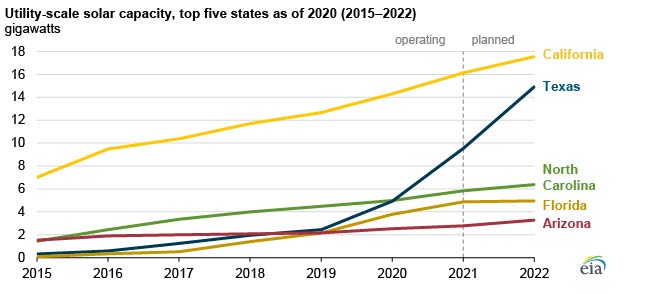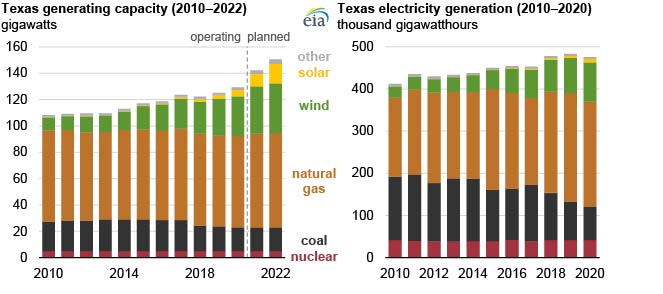
Texas, already the U.S. state with the most wind energy capacity, is catching up to California in utility-scale solar capacity. California currently has the most installed utility-scale solar capacity of any state. According to survey reports on EIA’s Preliminary Monthly Electric Generator Inventory, Texas will add 10 gigawatts (GW) of utility-scale solar capacity by the end of 2022, compared with 3.2 GW in California. One-third of the utility-scale solar capacity planned to come online in the United States in the next two years (30 GW) will be in Texas.
The installation of 2.5 GW of solar capacity in 2020 marked the beginning of the solar boom in Texas. We expect the state to add another 4.6 GW of solar capacity in 2021 and 5.4 GW in 2022, which will bring total installed solar capacity in Texas to 14.9 GW.
The federal solar Investment Tax Credit (ITC) that is available to project developers is driving some of the anticipated solar growth. Utility-scale solar projects that start construction in 2021 or 2022 are eligible for a 26% tax credit. The tax credit drops to 22% for projects that start in 2023 and to 10% for projects that start in 2024 or later.
Other factors driving solar investment in Texas include lower solar technology costs and plentiful sunlight, particularly in West Texas’s Permian Basin, where about 30% of the state’s planned solar capacity will be built. In addition, because solar generation is greatest in the middle of the day, when wind generation is typically lower, available transmission lines that already handle the large amount of wind power in the state have helped set the path for record-breaking planned solar capacity additions.
Despite recent solar capacity growth in Texas, utility-scale solar only made up 4% of the state’s generating capacity in 2020 and 2% of in-state electricity generation. In comparison, natural gas made up 53% of Texas’s capacity in 2020 and 52% of in-state generation; wind made up 23% of capacity and 20% of in-state generation.
Although wind capacity in Texas has grown rapidly in recent years, solar is expected to make up the largest share of the state’s capacity additions between 2020 and 2022. Almost half of the additions during this time period will be solar, surpassing wind (35%) and natural gas (13%) additions.



Follow us on social media: